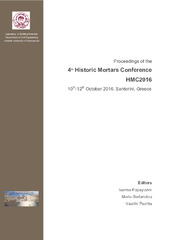Приказ основних података о документу
Roman Mortars from the Amphitheatre of Viminacium
| dc.contributor | Papayianni, Ioanna | |
| dc.contributor | Stefanidou, Maria | |
| dc.contributor | Pachta, Vasiliki | |
| dc.creator | Nikolić, Emilija | |
| dc.creator | Radivojević, Ana | |
| dc.creator | Delić-Nikolić, Ivana | |
| dc.creator | Rogić, Dragana | |
| dc.date.accessioned | 2023-08-22T12:41:02Z | |
| dc.date.available | 2023-08-22T12:41:02Z | |
| dc.date.issued | 2016 | |
| dc.identifier.isbn | 978-960-99922-3-7 | |
| dc.identifier.uri | http://rai.ai.ac.rs/handle/123456789/589 | |
| dc.description.abstract | Although the first archaeological excavations of Viminacium, the capital of the Roman province Moesia Superior, today's Serbia, began in 1882, only a small amount of laboratory research on applied building materials has been conducted so far. he grandeur and uniqueness of the building of the Roman amphitheatre now being excavated, and the need for its conservation, required the start of the research on the lime mortars used in this building. Some of the results of this particular research are presented in this paper. | sr |
| dc.language.iso | en | sr |
| dc.publisher | Thessaloniki: Laboratory of Building Materials. Department of Civil Engineering. Aristotle University of Thessaloniki | sr |
| dc.relation | info:eu-repo/grantAgreement/MESTD/Integrated and Interdisciplinary Research (IIR or III)/47018/RS// | sr |
| dc.rights | openAccess | sr |
| dc.source | Proceedings of the 4th Historic Mortars Conference (HMC 2016), Santorini, Greece | sr |
| dc.subject | Roman mortar | sr |
| dc.subject | Viminacium | sr |
| dc.subject | amphitheatre | sr |
| dc.title | Roman Mortars from the Amphitheatre of Viminacium | sr |
| dc.type | conferenceObject | sr |
| dc.rights.license | ARR | sr |
| dc.rights.holder | sr | |
| dc.citation.epage | 144 | |
| dc.citation.spage | 137 | |
| dc.identifier.fulltext | http://rai.ai.ac.rs/bitstream/id/1461/bitstream_1461.pdf | |
| dc.identifier.rcub | https://hdl.handle.net/21.15107/rcub_rai_589 | |
| dc.type.version | publishedVersion | sr |


